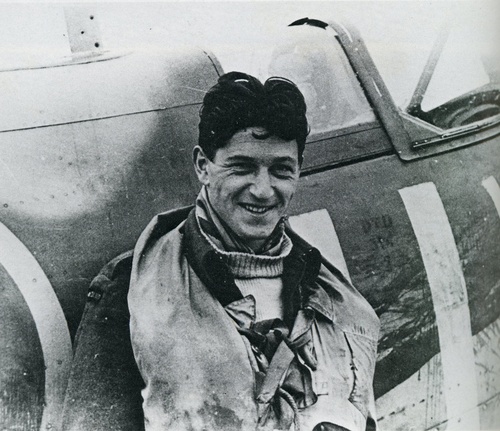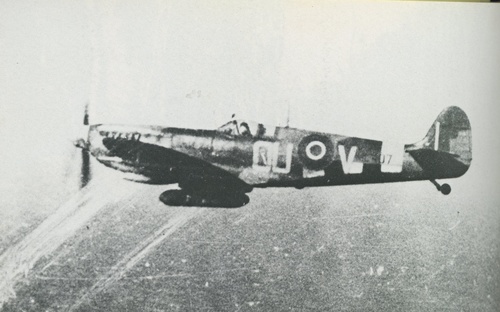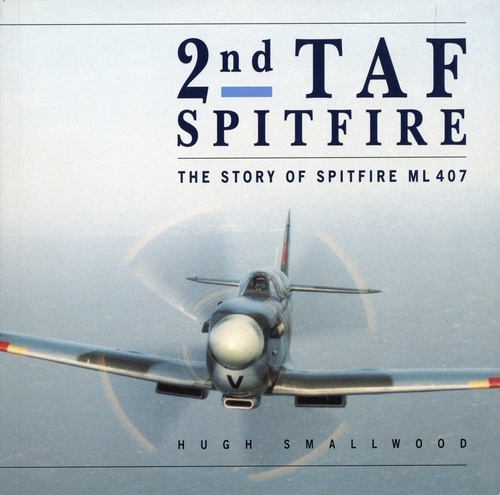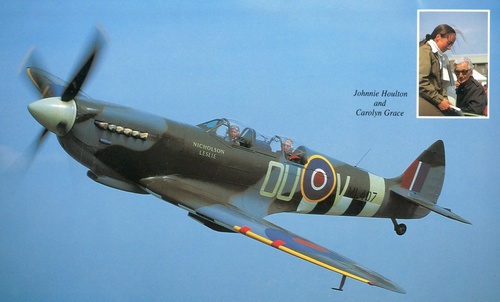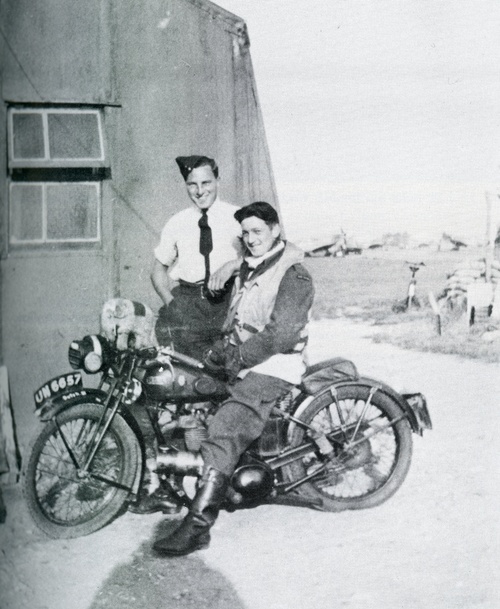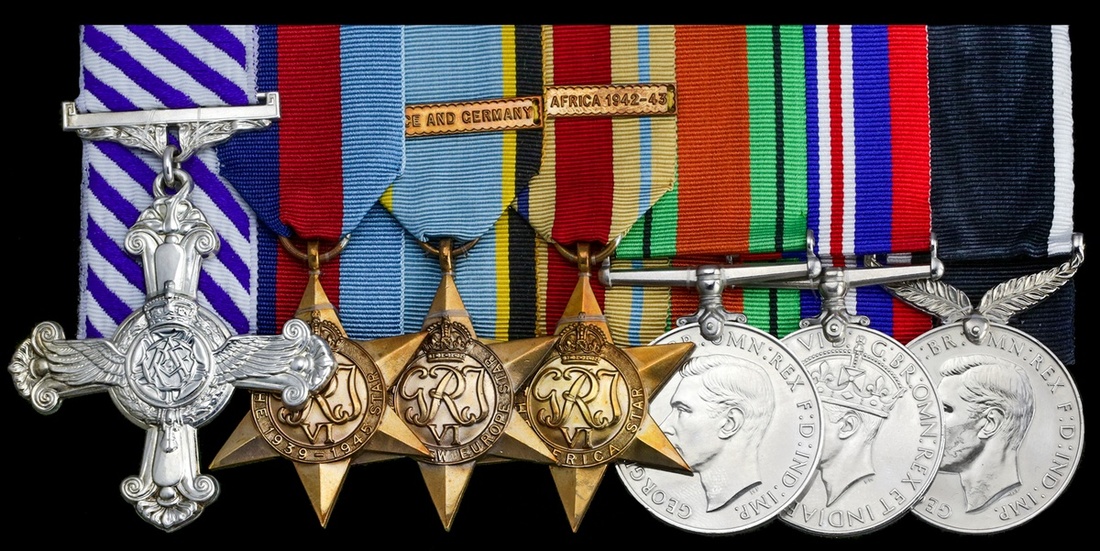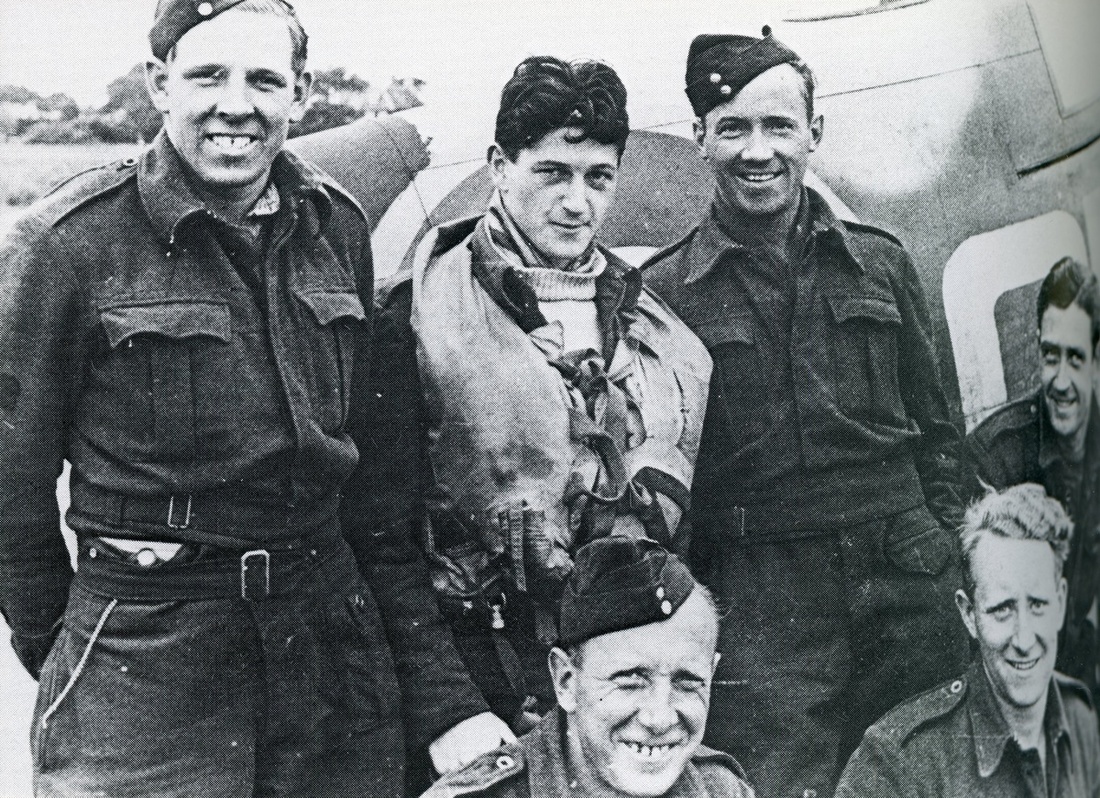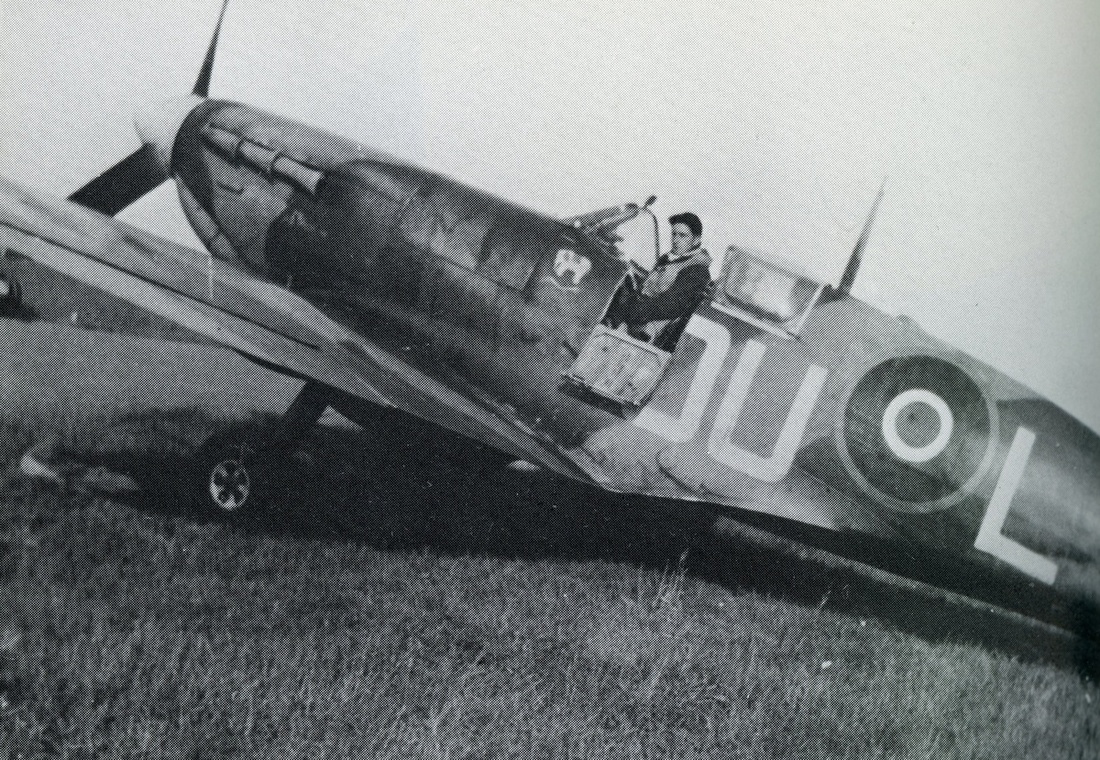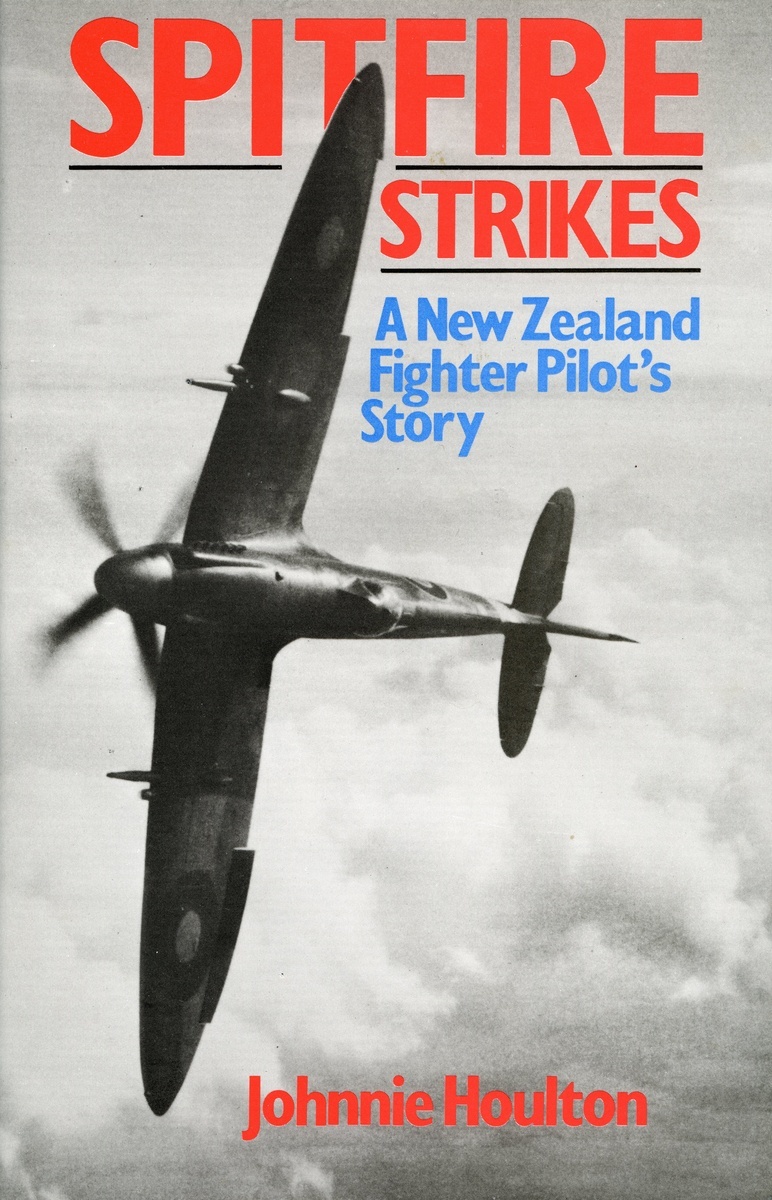Auction: 19002 - Orders, Decorations and Medals
Lot: 408
'In the mid-afternoon [of D-Day] I led Blue Section … South of Omaha beach, below a shallow, broken layer of cumulus, I glimpsed a Ju. 88 above cloud, diving away fast to the south. Climbing at full throttle I saw the enemy aircraft enter a large isolated cloud above the main layer, and when it reappeared the other side I was closing rapidly. Our aircraft were equipped with the gyro gunsight which eliminated the snap calculations and guesswork required to hit a target aircraft - especially one in a reasonably straight flight path; and it also enabled the guns to be used accurately at a far greater range than before. I was well aware, however, that most pilots were sceptical of the new instrument and preferred to use the conventional type of sight, which was still incorporated on the screen of the new sight. Normally one would open fire at ranges below 250 yards; but I adjusted the gyro sight on to the target at 500 yards with a deflection angle of 45-degrees, positioned the aiming dot on the right-hand engine of the enemy aircraft, and fired a three-second burst. The engine disintegrated, fire broke out, two crew members baled out and the aircraft dived steeply to crash on a roadway, blowing apart on impact … Supreme Headquarters nominated the Ju. 88 as the first enemy aircraft to be shot down since the invasion began, putting 485 (N.Z.) Squadron at the top of the scoreboard for D-Day. Some days before the invasion I had casually suggested we should run a sweepstake for the first pilot to shoot down and enemy aircraft after the invasion began, and I duly collected a few shillings from the pool. When we later had time to unwind and celebrate, my modest winnings were well short of the cost of the party.'
Squadron Leader J. A. 'Johnnie' Houlton, D.F.C., R.N.Z.A.F., counts the cost of being the first pilot to down an enemy aircraft on D-Day; Spitfire Strikes, refers.
The outstanding Second World War fighter ace's D.F.C. group of seven awarded to Squadron Leader J. A. 'Johnnie' Houlton, Royal New Zealand Air Force, who was credited with the first enemy aircraft destroyed over Normandy on D-Day
He opened-up his account in a Spitfire of No. 185 Squadron off Malta in November 1942 - when he severely damaged and probably destroyed a brace of Ju. 52s - and closed it in a Tempest of 274 Squadron over Germany in May 1945, when he destroyed a Do. 217
In the interim - in the period August 1943 to June 1944, whilst operating out of Biggin Hill - he gained ace status in a spate of successful combats over France in Spitfires of 485 (N.Z.) Squadron, victories that no doubt persuaded him to entitle his compelling and forthright autobiography Spitfire Strike: he attributed such success - and his survival - to his favoured habit of breaking hard into the line of fire rather than try and avoid it
In the summer of 1985, Houlton visited the U.K. to participate in a television documentary 'The Perfect Lady', so entitled because it witnessed him returning to the skies in his old D-Day war horse - Spitfire ML407 - a remarkable survivor which had been refurbished and converted to a two-seater and painted in the same markings and insignia used by him over Normandy 40 years earlier
For coverage of that memorable event and related interviews with Houlton, see:
https://www.youtube.com/watch?v=gp0Mp3bU7Oc
https://www.youtube.com/watch?v=h45IIo98UkU
Distinguished Flying Cross, G.VI.R., the reverse officially dated '1944'; 1939-45 Star; Air Crew Europe Star, clasp, France and Germany; Africa Star, clasp, North Africa 1942-43; Defence and War Medals 1939-45; New Zealand Service Medal 1939-45, generally good very fine (7)
D.F.C. London Gazette 5 September 1944. The original recommendation states:
'On 11 July 1942, on a 'Rhubarb' to Ostend, he destroyed a locomotive and damaged another. On 27 August 1943, he destroyed a Fw. 190, whilst acting as high cover to Fortresses. On 22 May 1944, he led Red Section on a 'Ranger', attacking and damaging two tanks and troop transport. Since D-Day this officer has destroyed one Ju. 88 and two Me. 109s and shared in the destruction of another Ju. 88.
As will be seen from the particulars above and the details of sorties carried out, this officer has at all times set a fine example to his fellow pilots by his initiative and keenness to come to grips with the enemy.'
John Arthur 'Johnnie' Houlton was born in Christchurch, New Zealand on 23 September 1922. After beginning work as a public service cadet, he joined the Royal New Zealand Air Force and, having qualified for his 'Wings', he was embarked for England in December 1941.
Following a refresher course, he was posted to No. 485 (N.Z.) Squadron at Kenley in June 1942, but in the following month he volunteered for Malta. He was duly embarked in the carrier H.M.S. Furious and flew a Spitfire off her to the besieged island on 11 August.
Malta sojourn - No. 185 Squadron - first blood
Posted to No. 185 Squadron on his arrival, he was quickly taken ill with severe sinus and other ailments caused by local conditions. As he later observed in Spitfire Strikes:
'Fresh water was in short supply and there was no hot water at all; which made hygiene a myth … while we were half-starved, the mosquitos, sand flies, bed bugs and fleas fed very well.'
Cleared for operations by late October, he was selected with three other pilots to bomb Gela aerodrome in Sicily on 28 November, their Spitfires being fitted with suitable bomb racks. On returning from the raid, eight Ju. 52 transports were spotted heading for North Africa. Houlton takes up the story:
'I attacked in turn each of the three aircraft on the left of the formation, starting with the rear one. As the 20mm. guns fired only one round I had to do the best I could with the four .303 machine-guns and was surprised by the amount of return fire from the formation. At least some of the aircraft had upper gun turrets, and it also appeared that some irate passengers were using automatic weapons through the windows. The first Ju. 52 dropped below the formation and turned towards Sicily, and the next two were still descending steeply towards the sea when the Me. 109 escort came diving down, and I ducked into a handy cloud … About one week later a telephone call from Headquarters advised that 'Y' Service had confirmed at least one Ju. 52 crashing into the sea' (ibid).
German records that later came to light established the loss of three Ju. 52s from this flight.
Houlton returned to the U.K. at the end of the year on being ordered to join a Search and Rescue Squadron. Instead he was posted to No. 602 Squadron and thence, by special request in late February 1943, back to No. 485 (N.Z.) Squadron.
No. 485 Squadron - successive Spitfire strikes - D-Day's first 'kill'
Thus commenced a flurry of cross-Channel sweeps and bomber escort sorties, particularly after the Squadron's transfer to Biggin Hill in July 1943. In the period leading up to the recommendation for his D.F.C. in June 1944, he flew 100 operations and firmly established himself as a fighter ace.
Commissioned Pilot Officer in August 1943, Houlton gained his first victory over St. Pol on the 27th, when he downed a Fw. 190. He pursued his prey for 30 miles, descending from 27,000 feet to deck level, where the Fw. 190 caught a power line and smashed into the ground. It had been a terrifying encounter, Houlton having nearly blacked out after a new aircraft elevator modification sent his Spitfire in a succession of tight turns:
'I was virtually cemented in position, as it was physically impossible to lift hands, feet or head against that amount of g, and we just kept careering around in a steep, left-hand descending turn; like winding down a giant, corkscrewing spiral … '
Two or three weeks later - on 16 September - he took a half-share in another Fw. 190 over Beaumont-le-Roger and damaged a 109. Once again, the pilot of the Fw. 190 proved a worthy opponent, the pair of them leaving vapour trails that resembled 'a crazy pattern of irregular white arcs and angles' in their wake - 'the amount of g we were both pulling in the turns was dragging hard, my own vision hovering between grey-out and black-out.' Houlton continues:
'As his turn rate momentarily slackened at the stall in a steep turn, I managed to pull through his flight path to fire a short burst which produced a flurry of bright strikes on the wing-root. As the 190 pilot flicked away into an opposite turn he flew right into Bert's line of fire, and a short burst smashed the aircraft down into the woods with a great shower of debris' (ibid).
The Squadron was now ordered to Scotland for a rest but it resumed operations out of Hornchurch in February 1944, as part of 2nd Tactical Air Force (T.A.F.). The unit's Spitfires were modified to carry a 500 lb. bomb under the fuselage and during the six weeks leading up to D-Day Houlton flew 11 dive-bombing sorties. On one such outing his bomb hung up but he defied orders and landed safely back at base rather than heading out to sea and baling out. He was reprimanded.
A few days later, as cited, Houlton claimed the first 'kill' obtained by an Allied pilot over Normandy on D-Day, destroying a Ju. 88 and sharing in another. The Spitfire he flew during this sortie - ML407 OU-V - is still flying today in the U.K.; see above. He was awarded the D.F.C.
Two days later, west of Caen, he shot down a 109 which crashed into a wood - 'Just before crashing an object came away but not a parachute' (his combat report refers). He promptly followed up this victory by destroying another 109 in a combat on the 11th, the enemy aircraft catching fire, breaking up and crashing in a cornfield. On this occasion, however, 'At the height of about 600 feet, the pilot was thrown clear and his parachute opened' (ibid).
His final encounter over Normandy took place on the 29th, when he damaged a 109 south of Caen.
In late July 1944, Houlton was sent on temporary detachment to the Ministry of Aircraft Production, undertaking a tour to introduce the new Gyro gunsight that his squadron had helped to develop. Relieved to return to operations with 485 Squadron in August 1944 - now part of 2nd T.A.F's 135 Wing - he flew to an advanced airfield in France on the last day of the month. Further sorties ensued, but Houlton was finally 'rested' and attended the Fighter Leaders' School and the Central Gunnery School, prior to spending a couple of months as an instructor at a Spitfire O.T.U.
No. 274 Squadron - one final burst
He returned to operations in 135 Wing in Holland in the Spring of 1945, when he joined No. 274 Squadron, a Tempest unit, as a Flight Commander. And it was in this capacity that he claimed his last victory, a Do. 217 shot down south-west of Kiel:
'One week before Germany capitulated, however, a Dornier bomber flew right underneath me at zero feet, heading in the general direction of Norway. A two-second burst from the four 20mm. guns brought an end to the attempted escape, which meant I had accounted for the last - as well as the first - of the enemy aircraft destroyed by 135 Wing of the R.A.F. 2nd Tactical Air Force' (ibid).
Houlton was promoted to Squadron Leader in July 1945 and returned to New Zealand at the war's end.
The latter years
From 1952-55 Houlton flew with 41 (T.) Squadron, R.N.Z.A.F. and for the next 10 years he flew on aerial photographic, charter, subsidiary and agricultural operations. In 1965, with Don Hutton, he formed the Agricultural Pilots' Association of New Zealand, with the object of eliminating an excessive rate of avoidable accidents and stabilising pilots' conditions of work. From 1976-83, Houlton was in charge of the New Zealand Defence Department's Field Station on Great Barrier Reef.
As cited above, Houlton returned to the U.K. in 1985, shortly after the occasion of the 40th Anniversary of the Normandy landings, a very special trip for he was re-united with his D-Day Spitfire - ML 407 OU-V - and his surviving ground crew; a memorable flight in the converted two-seater followed and the plain-speaking Houlton enthralled a wide audience in subsequent interviews. The 'V' of OU-V stood for 'Vicki', 'the girl I met after returning from Malta, who all the 485 boys were a little in love with, and who became my wife.'
Houlton continues:
'In July 1985 I was able to fly again in ML 407, in England, during the filming of "The Perfect Lady", the Spitfire commemorative film produced by T.V.S. This was a very moving experience, made even more memorable by the fact that my old aircraft again carried the markings and insignia of OU-V, precisely as they were in May of 1944' (2nd T.A.F. Spitfire - The Story of Spitfire ML 407, refers).
Houlton had flown his first Spitfire with the letters OU-V from Biggin Hill in the summer of 1943; remarkably, this aircraft also survives to this day in the collection of the Norwegian Air Force Museum.
Undoubtedly a trade-mark 'Kiwi' fighter pilot of the very best kind - full of guts and forthright in opinion - the gallant Houlton settled at Whangaparaoa, north of Auckland. He died there in April 1996.
Sold with the recipient's original R.N.Z.A.F. Pilot's Flying Log Book, covering the period July 1941 to September 1945, the closing pages with a summary of his 'kills'; together with a
copy of his autobiography Spitfire Strikes (John Murray, London, 1985), and 2nd T.A.F. Spitfire - The Story of Spitfire ML 407, by Hugh Smallwood (Solo Enterprises, Halstead, 1994); two video cassettes commemorating ML 407, entitled 'The Perfect Lady' and 'Absolute Heaven'; and related commemorative stamps and phone card.
Subject to 20% VAT on Buyer’s Premium. For more information please view Terms and Conditions for Buyers.
Sold for
£6,000
Starting price
£4000


